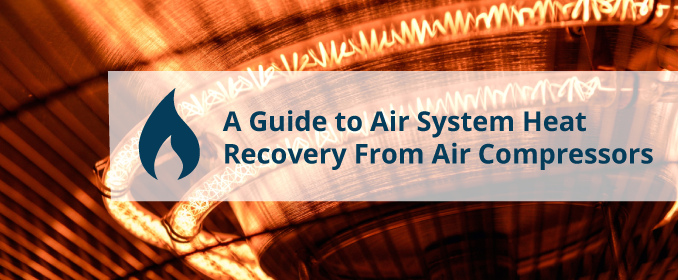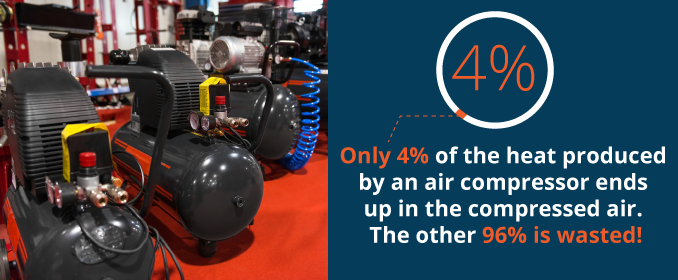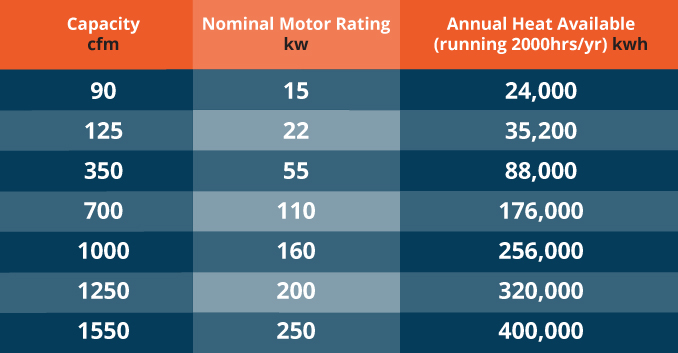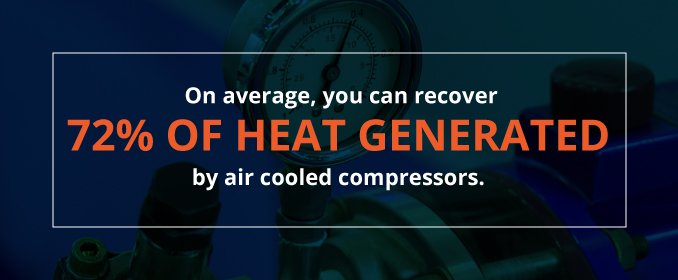
The cost of electricity seems to go up every year, so it’s no surprise that businesses are looking at new ways to lower their energy use. Did you know that your air compressor can help you save energy?
Many businesses consider compressed air among their most expensive utilities. Electricity to run an air compressor can account for 76 percent of the total cost of a compressor.
What if you could recoup some of that expense?
A compressed air heat recovery system can help you reduce your overall energy use. You’ll save money and reduce your electricity use. You’ll also have a steady alternative source of heating and reduce your greenhouse gas emissions.
Air compressors can generate a lot of heat. For example, a 25 horsepower air compressor can generate enough heat to warm a house.
But most of this heat is wasted. In fact, only 4 percent of the heat produced by an air compressor ends up in the compressed air. The other 96 percent is wasted!
As an example, here’s a breakdown of heat balance within a typical rotary air compressor:
Input power: 100%
Total Reclaimable heat: 94%
Heat from electric motor: 9%
Heat from oil cooler: 72%
Recoverable heat from after-cooler: 13%
Total Lost heat: 6%
Radiation loss: 2%
Heat remaining in compressed air: 4%
Industries have made large advances in reclaiming this heat for other uses. Today, more than 90 percent of the heat generated by an air compressor can be reclaimed. Businesses use it to heat water, replace their furnaces, dry paint, and cook food.
Heat from air compressors is most often used for process heating and drying. It’s also becoming popular for chemical manufacturers and food businesses to use their reclaimed heat.
Reclaimed heat is also used in space heating. Businesses can connect their compressor to HVAC ducting to avoid other space heating costs. Some businesses even use their excess heat for warming food and beverages.
How Much Energy Can You Save With Compressed Air System Heat Recovery?
For many businesses, heating and cooling is one of the most expensive operating costs. A typical office in the northern US can spend nearly 40 percent of its electricity on heating. And it’s not just space heating. Most businesses use another 6 percent of their electricity on heating water.
For many industries, heating demands are even higher. Steam and process heating can account for more energy use than space heating.
With these costs, it’s easy to see how reclaiming heat from an air compressor can mean significant cost savings. As an example, a heat recovery air compressor in the United Kingdom can save businesses over 12,000 pounds.
But utility prices vary between locations. They also change over time. Instead of a fixed price, consider how much energy you can save. This will help you get the most accurate idea of your potential savings.
For instance, a small compressor might use just 15 kilowatts of electricity. But that compressor could generate 24,000 usable kilowatt hours of heat each year.
If your electricity costs just $0.10 per kilowatt hour, you would save over $2,400 per year. If your electric costs jump to $0.15 per kilowatt hour, your cost savings would obviously go up as well.
Typical Heat Availability From Compressors
A recent study in the U.S. looked at reclaiming heat from furnaces, which generate less excess heat than air compressors. Could reclaiming this heat also help lower utility bills?
The study that found that reclaiming heat from furnaces would save businesses over $20 million. Businesses would use 1 million MMBtu per year less natural gas. They would also reduce carbon dioxide emissions by 182,000 metric tons.
The results are clear. Reclaiming heat can benefit both the environment and your bottom line.
How to Calculate Your Cost Savings from Reclaiming Heat
Nationally, reclaiming heat from air compressors can save a significant amount of money. But what about your business?
Talking to a compressor specialist is the most effective way to learn about heat recovery. You can find a local service specialist through Quincy Compressor. We can help you understand how much heat your compressor generates and also suggest equipment that will allow you to reclaim this heat.
You can also estimate how much heat you’ll be able to reclaim. This will give you an idea of your potential cost savings. An energy auditor can help you refine your estimates later.
To determine your individual savings, you’ll need the following pieces of information:
-
- Compressor bhp:This is your compressor shaft horsepower. It’s usually slightly higher than the motor horsepower. Check your equipment specifications to find the bhp.
- Compressor hours of operation:This is the total amount of time that your compressor operates. You can calculate hours of operation either per month or per year. Using the annual number of hours operated can help you adjust for seasonal variations.
- Unit of fuel:You’ll need to know what your utility company considers a unit of fuel. Kilowatt hours, cubic feet, gallons and therms are all common units of fuel.
- Cost of a unit of fuel:
Most utility companies charge by the unit of fuel used. This can be the price per kilowatt hour, cubic foot, or gallon. If the cost of fuel varies by season, peak usage, or time of day, it may help to use an average.
Estimating Energy Savings
You’ll need to know your compressor shaft horsepower and hours of operation for this formula. You’ll also need to have an idea of how much heat you can recover.
The recoverable heat percentage for an air cooled compressor is usually at least 70 percent. For a water cooled compressor, 50 to 60 percent is more common. With some compressor models, you can recover more than 90 percent of the heat generated.
To calculate your energy savings from reclaiming heat, you’ll use the following formula:
Energy savings = (Compressor bhp) * (2,545 Btu/bhp-hour) * (Hours of operation) * (Recoverable heat percentage)
As an example, let’s say that you have a 100 hp compressor that runs 40 hours per week. It’s air cooled, and you think you’ll be able to reclaim about 70 percent of the heat it generates.
(100 bhp) * (2,545Btu) * (2080 hours per year) * (.70 reclaimed heat) = 370,552,000 Btu of reclaimed heat per year
Estimating Cost Savings
So you know you can reclaim up to 370,552,000 Btu of heat each year from your 100 horsepower compressor. So how much can reclaiming this heat save you?
To figure out your cost savings, you’ll need one more formula:
Cost savings ($/year) = (Btu/year of energy savings) / (Btu/unit of fuel) * (cost of unit of fuel)
If you’re not sure what the Btu of a unit of fuel is, Think Energy has a list of conversions for common units. There are also many calculators available for the Btu of different units of fuel.
Let’s say that your primary power source is electric. Electric costs $0.14 cents per Kilowatt hour. For our previous example of a 100 horsepower compressor, your equation will be:
(370,552,000 energy savings) / (3,412 Btu/kilowatt hour) * (.14 per kilowatt hour) = $15,204.36 savings per year
So if you reclaim the heat from your air compressor, you’ll be able to save your business more than $15,000 per year in electricity costs.
How Much Heat Can Be Recovered From Different Types of Compressors?
All compressors convert energy into heat and most can be adapted to reclaim this heat. But some compressors are more efficient than others.
Heat recovery technology has advanced in recent years. Today more than 90 percent of heat generated by an air compressor can be recovered.
In practice, reclaiming the maximum percentage may not be cost effective. The heat recovery equipment needed may outweigh the potential savings. Your business may not be able to use the amount of heat recovered. Or the time that you generate heat does not match the times that you need heat.
More realistic percentages of heat recovery are between 50 percent and 80 percent. The amount of heat recovered depends on the type of compressor and cooling method.
Air Cooled Compressors
Air cooled compressors are one of the most common air compressors. On average, you can recover 72 percent of heat generated by air cooled compressors. Most often, heat from an air cooled compressors is used for space heating. It’s also sometimes used for process heating.
Water Cooled Compressors
Water cooled compressors also generate heat that can be reclaimed. Heat from water cooled compressors is an excellent choice for heating fluids. That’s because fluid-to-fluid heat exchange is more efficient. It’s often used for process heating. You can expect to reclaim 50 to 60 percent of the heat generated.
Best Businesses for a Compressed Air Heat Recovery System
More than just your equipment affects heat recovery. You’ll also need to take your heat needs into account.
Some companies have a steady demand for heat. Businesses that use process heating fall into this category. Others have a seasonal or variable need for heat.
Ask yourself the following questions:
- Does your need peak at certain times of day?
- Is it a seasonal need?
- Is piping the heat to where it’s needed realistic?
Consider these elements of your heating demands:
- How much heat your business needs
- The type of heat you need (process heating, drying, steam, space heating)
- The time and location of heat generated
- The time and located of heat needed
Heat recovery from a compressed air system is most useful for businesses that use process heat. Companies that use process heating regularly can simply redirect heat from compressed air.
Chemical manufacturers are in an ideal position to take advantage of reclaimed heat. Businesses in the food industry can also use recovered heat easily. Electroplaters and paint shops also frequently use reclaimed heat for drying.
Businesses that don’t use process heating can also reclaim heat from air compressors. These businesses often use the heat for space heating. However, these businesses should factor in the seasonal demand for space heating.
Finally, many businesses recover heat from water-cooled compressors to heat water. Fluid exchange is one of the most efficient ways to recover heat.
Equipment Needed to Reclaim Heat From Air Compressors
The first step to recovering heat from your compressor is contacting a compressor specialist.
These specialists will evaluate your compressor and your heat needs. They’ll help you determine the most effective way to reclaim heat from your compressor.
Many auditors can also recommend other ways to make your air compressor energy efficient. These techniques might include:
- Leak sealing
- Changing your machine’s psi
- Scheduled changes
Most of the time, reclaiming heat will need additional equipment or retrofits. Some newer compressors are sold with heat recovery options. If you need to retrofit your compressor, the cost of equipment is usually less than the potential savings. Here are two of the most common types of changes you can make:
- Space Heating.If you plan to reclaim heat for space heating, you’ll need to connect your compressor to an HVAC system. This is usually done by connecting the compressor discharge to the ducting. Most businesses install dampers at the same time. When heat isn’t needed, you can discharge excess heat via external exhaust.
Installing ducting is a relatively simple process. If they’re not already in place, it’s important to install HVAC controls. Heating discharged via ducting can reach up to 176 F. These controls will reroute excess heat to the atmosphere.
- Water Heating and Process Heating.Heating water with recovered heat is most effective with a fluid cooled compressor. It’s best done when a compressor is fluid cooled. Fluid-to-fluid heat transfer is more effective than air-to-fluid heat transfer.
To reclaim heat from a water cooled air compressor, you’ll need a water exchanger. Fluid-to-fluid heat exchangers use a heat exchange fluid that circulates through pipes. They absorb heat from the compressor’s cooler, then transfer that heat to the intended liquid.
Many businesses worry about transferring material between the compressor and the heated fluid. But there is little to no risk of transferring chemicals or particles. You can actually use your compressor to heat drinking water. That’s because heat exchangers have barriers between the source fluid and the heated liquid. These barriers can be either single or double walled.
Using Reclaimed Heat for Multiple Purposes
Some businesses choose to use reclaimed heat for more than one purpose. If you do this, you’ll need equipment to transition between different uses. Installing this equipment can be a good option if your heat needs change over the year.
For instance, some companies use reclaimed heat for space heating in the winter. During the summer, they transition to using reclaimed heat for water heating or paint drying.
Contact Us Learn More Find a Dealer Near You
Take the First Steps to Reclaim Heat From an Air Compressor
One of the first steps is to contact a compressed air specialist to help you determine whether an air compressor heat recovery system is the right choice for you.
To get started with lowering your energy use, contact Quincy Compressor today. Our service representatives will help you assess your system and recommend ways that you can recover heat from it.
Table of Contents
- How Much Energy Can You Save With Compressed Air System Heat Recovery?
- Typical Heat Availability From Compressors
- How to Calculate Your Cost Savings from Reclaiming Heat
- Estimating Energy Savings
- Estimating Cost Savings
- How Much Heat Can Be Recovered From Different Types of Compressors?
- Best Businesses for a Compressed Air Heat Recovery System
- Equipment Needed to Reclaim Heat From Air Compressors





